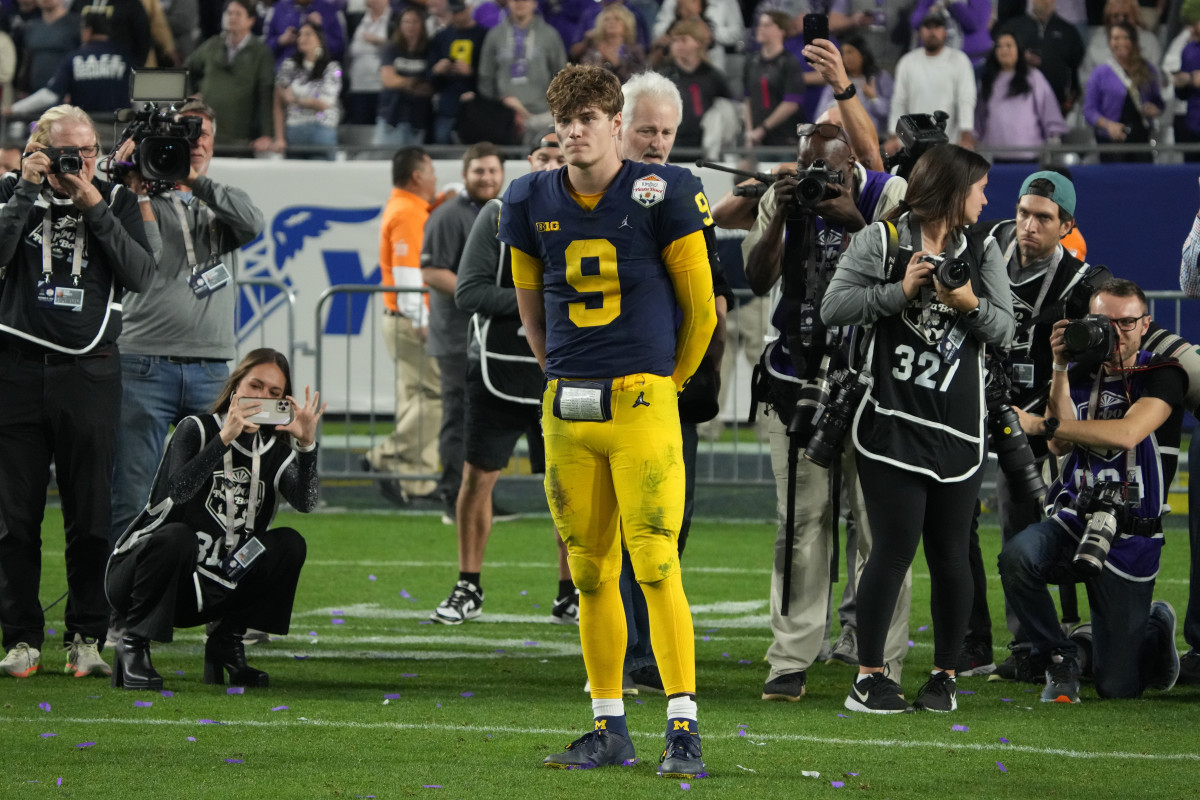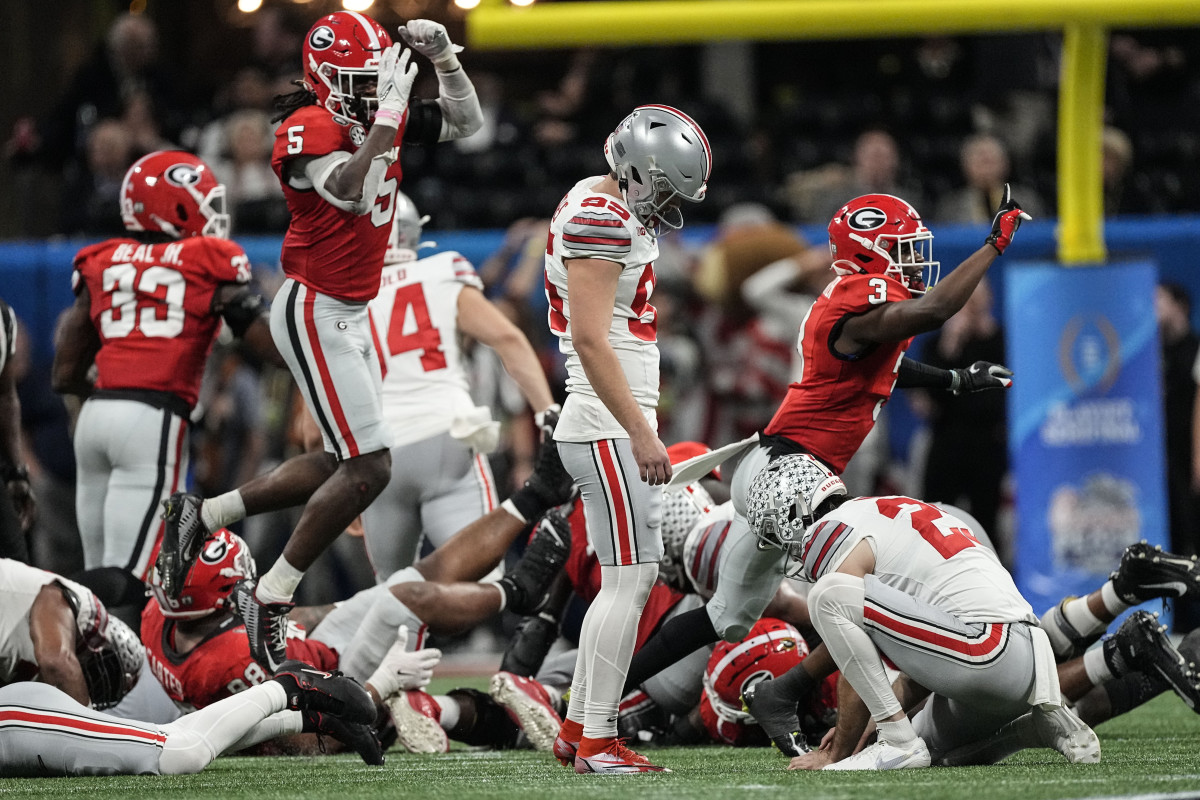#PlayoffFail: Michigan, Ohio State, Big Ten Get Big Dose of Humility
For six months, the Big Ten Conference was the biggest winner in college football. On June 30, the league shook up the sport with the acquisition of USC and UCLA, pirating the Los Angeles market away from the Pac-12 come 2024. In August, the Big Ten announced a new record-setting media rights deal that will shower its members with cash. And on Selection Sunday for the College Football Playoff in early December, two conference members made the four-team field for the first time.
Then came New Year’s Eve, when the Big Ten’s big year ended with a big bust. The league dropped the ball before the ball dropped in Times Square. The off-field summer gains will resonate in the future, but the present brings another dose of humility.
Michigan was upset by TCU in one playoff semifinal. Ohio State couldn’t hold a two-touchdown lead against Georgia in the fourth quarter in the other. The Big Ten went 0-2 in the games that matter most, dropping its all-time playoff record to 3-7 and extending its championship drought to eight years.
The playoff games were thrilling, and there were points of pride for the Wolverines and Buckeyes. Michigan kept battling back against TCU, falling behind by 18 points in the first half and 19 in the second but repeatedly rallying to have a chance to win. Ohio State played its best game in years to put the reigning-champion Bulldogs on the ropes, showing a fortitude that had been questioned in the past.
But at the literal end of the day and year, when Noah Ruggles’s 50-yard field goal hooked far left in Atlanta at the stroke of midnight, the Big Ten’s flagship programs were swept out of the Playoff. The league’s underwhelming CFP résumé lost more luster. An opportunity to end 2022 with a powerful flex was gone.

The Midwest misery ran deeper Saturday for Michigan than Ohio State. The undefeated Wolverines were favored by more than a touchdown against the Horned Frogs, who were the most unlikely participant in CFP history. Michigan was rolling into the Playoff, stomping the Buckeyes in the regular-season finale at the Horseshoe and dominating Purdue in the Big Ten title game.
Yet, in the end, coach Jim Harbaugh’s program has contested 120 minutes of playoff football in consecutive seasons without leading for a single second. Last year, Michigan immediately fell behind Georgia and got run out of the Orange Bowl. On Saturday, the Wolverines squandered an opportunity for a fast start, fell behind 14-0 in the first quarter and 21-3 in the second, and were in desperate comeback mode the rest of the way.
For Ohio State, the pain comes from knowing it had a huge victory within reach and couldn’t squeeze it out. The Buckeyes had it, and let it get away. That’s different from the constant uphill battle fought by Michigan.
As I wrote Sunday, the Peach Bowl game came down to the narrowest margins of time and distance, and the most important moments all broke Georgia’s way. Ohio State didn’t turn the ball over, was flagged for just 24 penalty yards and converted many big plays. But there also were some key errors and breakdowns—a drive-killing illegal motion penalty, a defensive back who was blown by and left stumbling on a bomb pass, a bad play call in the final minute. They all added up.
Ultimately, both teams were not good enough defensively. That’s a recurring theme which could be indicative of being unprepared to face high-octane offenses after weekly doses of underwhelming opposition on that side of the ball.
For the second straight season, Michigan compiled gaudy defensive statistics and then was exploited in the Playoff. TCU’s 6.97 yards per play was the highest the Wolverines allowed all year. Georgia’s 7.89 per play last year in the Orange Bowl was a season-high against Michigan, as well. Alabama creased Harbaugh’s defense for a season-high 8.73 yards per play in the ’19 Citrus Bowl. Florida gouged Michigan for 6.67 in the ’18 Peach Bowl, second-highest that season to Ohio State’s 8.46.
For the Buckeyes, Georgia’s 8.88 yards per play was their highest allowed this season, even higher than the 8.83 Michigan dropped on them in the Horseshoe. (Another damning defensive stat from those two games: Ohio State was outscored 18-3 in the fourth quarter by the Bulldogs and 21-3 in the fourth by the Wolverines.) Last year, Utah scored a season-high 45 points against Ohio State. Alabama ripped Ryan Day’s defense for 52 points and 7.48 yards per play in ’20. Clemson posted season highs of 29 points and 6.73 yards per play in ’19.

Among Big Ten teams, Ohio State and Michigan are so far ahead of their peers offensively that their defenses might not be adequately prepared for postseason play. This season, the Buckeyes are No. 1 nationally in yards per play (7.28), while the Wolverines are 18th (6.62). After that, the rest of the league checks in at 40th (Penn State), 49th (Minnesota), 63rd (Wisconsin), 65th (Maryland), 80th (Purdue), 82nd (Michigan State), 86th (Nebraska), 93rd (Illinois), 123rd (Northwestern), 126th (Indiana), 127th (Rutgers) and 129th (Iowa).
The Southeastern Conference, meanwhile, has seven teams within the top 35 nationally in yards per play. The Big 12 has five. Whether it’s scheme or talent, the leagues of both Playoff finalists are farther along than the Big Ten offensively after its top two teams.
The other issue for Ohio State and Michigan could be the all-consuming nature of their rivalry game. In the past two seasons, winning that game was a direct path to the Big Ten title and the Playoff (this season, so was losing). The buildup began weeks, maybe even months, in advance, with both teams almost mundanely proceeding through the rest of the schedule. The competition did few favors in terms of seasoning and hardening them for the postseason.
Michigan won both, rolled over an outmanned Big Ten West opponent, and then lost in the Playoff in a disappointing performance. In fact, the Wolverines have lost their past six bowl games under Harbaugh. Gearing everything toward beating Ohio State is great if you want to win the conference, but if Harbaugh wants to win the national championship, he has some more tweaking to do.
This past offseason, Day seemed to be taking his program into Beat Michigan Mode with the hiring of a new defensive coordinator and the emphasis on becoming tougher in the trenches. While those changes were needed to compete for the Big Ten title and a national title, it didn’t pay off this season. The Buckeyes acquitted themselves nobly against Georgia, but there still is a level to attain beyond simply trying to counter-program your biggest rival.
So after six months of making news and breaking a Playoff barrier, the Big Ten has been dismissed to the sidelines. It will be an onlooker once again, not a participant, in the national championship game. Adding members and making money are nice, but the league’s on-field product needs some work.
Watch the CFP Championship live with fuboTV: Start a free trial today.
